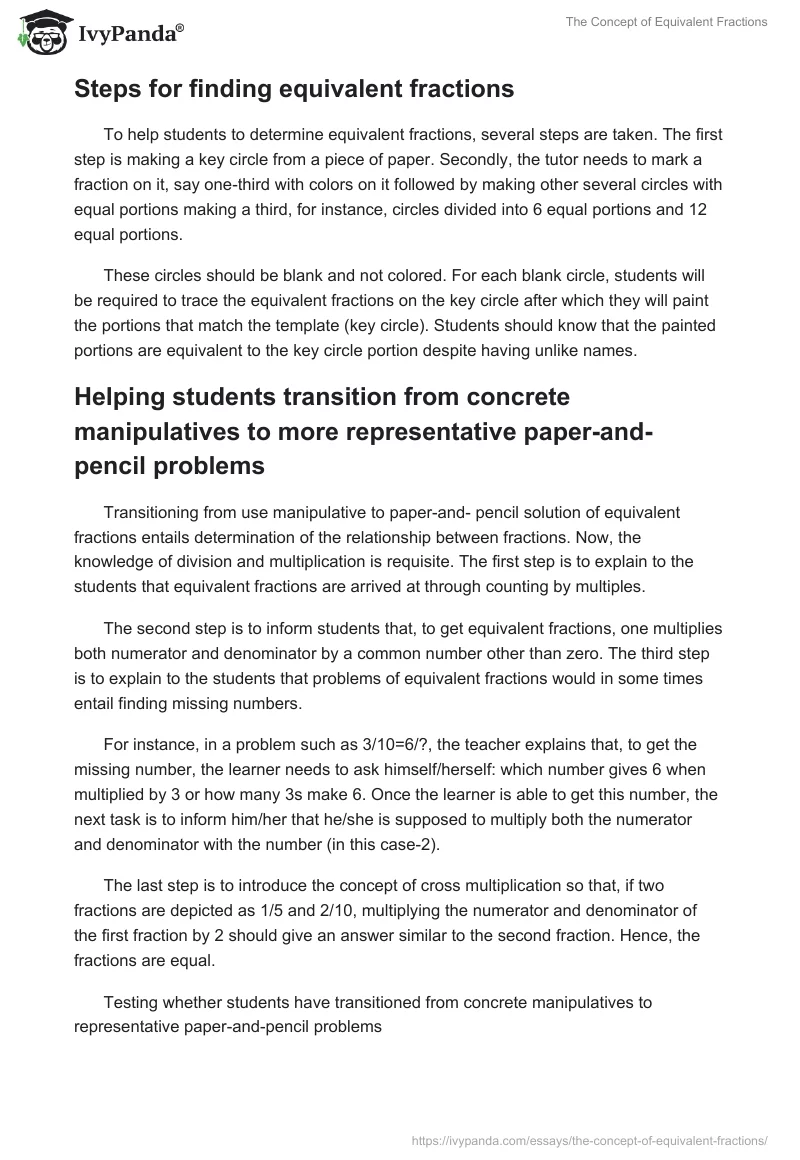Prerequisite skills to working with fractions with unlike denominators
When teaching fourth-grade students the concept of fractions with unlike denominators, it is necessary for them to have some prerequisite skills (Koch, 2010). These skills include an appreciation of the significance of a fraction (a method of computation of elements of groups of things, sections, and or parts).
Besides, learners need to have ample skills of not only classifying but also interpreting the elements of fraction in addition to possessing skills in division and multiplication of numbers from 0 through 12.
Fortunately, students have these tactics already developed by the time they get to the fourth grade (Reys, Lindquist, Lambdin & Smith, 2012) and hence the predicted easiness of understanding the theory of equivalent fractions of fourth graders.
Introducing the concept of finding equivalent fractions through manipulatives
To introduce the concept of manipulatives, a tutor can deploy the help of an overhead projector. Bars of different fractions are positioned next to one another though with varying colors. One-half and three-sixths are shown adjacent to one another.
One-half is shown by a rectangle partitioned twice with one of them painted red. The three-sixth fraction is shown by a rectangle divided into six portions with three portions shown in blue color. Comparing the two, students will appreciate the truth that the two colored portions are equal.
This experiment can be repeated for one-fourth, two-eighths, and three-twelfths for students to grasp the fact that equivalent fractions may have different names when they actually represent the same quantity.
Steps for finding equivalent fractions
To help students to determine equivalent fractions, several steps are taken. The first step is making a key circle from a piece of paper. Secondly, the tutor needs to mark a fraction on it, say one-third with colors on it followed by making other several circles with equal portions making a third, for instance, circles divided into 6 equal portions and 12 equal portions.
These circles should be blank and not colored. For each blank circle, students will be required to trace the equivalent fractions on the key circle after which they will paint the portions that match the template (key circle). Students should know that the painted portions are equivalent to the key circle portion despite having unlike names.
Transitioning students from manipulatives to paper-and-pencil fractions
Transitioning from use manipulative to paper-and- pencil solution of equivalent fractions entails determination of the relationship between fractions. Now, the knowledge of division and multiplication is requisite. The first step is to explain to the students that equivalent fractions are arrived at through counting by multiples.
The second step is to inform students that, to get equivalent fractions, one multiplies both numerator and denominator by a common number other than zero. The third step is to explain to the students that problems of equivalent fractions would in some times entail finding missing numbers.
For instance, in a problem such as 3/10=6/?, the teacher explains that, to get the missing number, the learner needs to ask himself/herself: which number gives 6 when multiplied by 3 or how many 3s make 6. Once the learner is able to get this number, the next task is to inform him/her that he/she is supposed to multiply both the numerator and denominator with the number (in this case-2).
The last step is to introduce the concept of cross multiplication so that, if two fractions are depicted as 1/5 and 2/10, multiplying the numerator and denominator of the first fraction by 2 should give an answer similar to the second fraction. Hence, the fractions are equal.
Testing whether students have transitioned from concrete manipulatives to representative paper-and-pencil problems
To determine whether students have transitioned from manipulative to representative paper-and-pencil problems effectively, students are required to fill missing gaps for equivalent fractions such as the ones shown below:
Reference List
Koch, J. (2010). Science stories: Science methods for elementary and middle schoolteachers. Wadsworth Cengage Publishing.
Reys, R., Lindquist, M., Lambdin, D. & Smith, N. (2012). Helping children learn mathematics. Hobokon, NJ: John Wiley & Sons.


